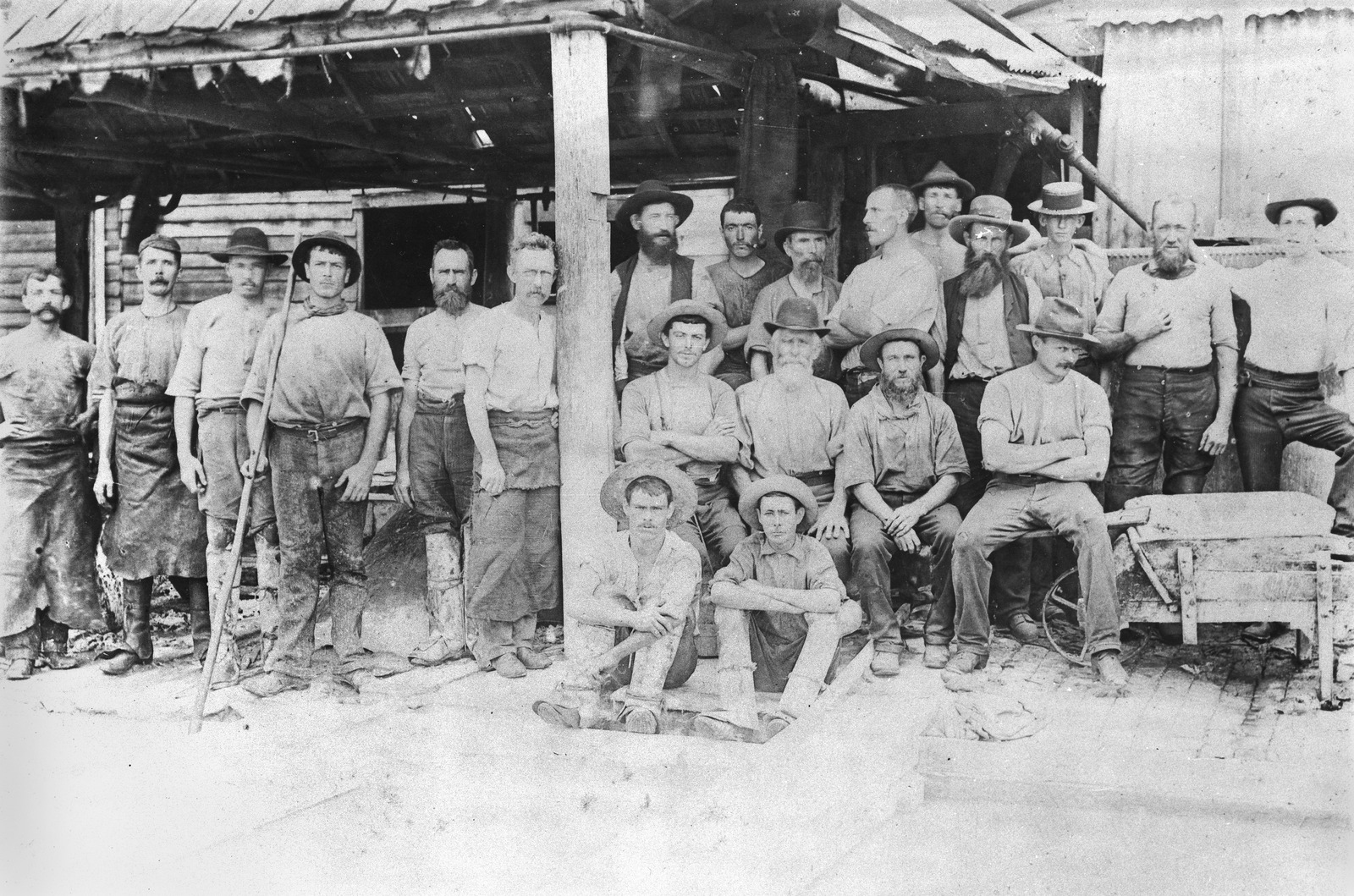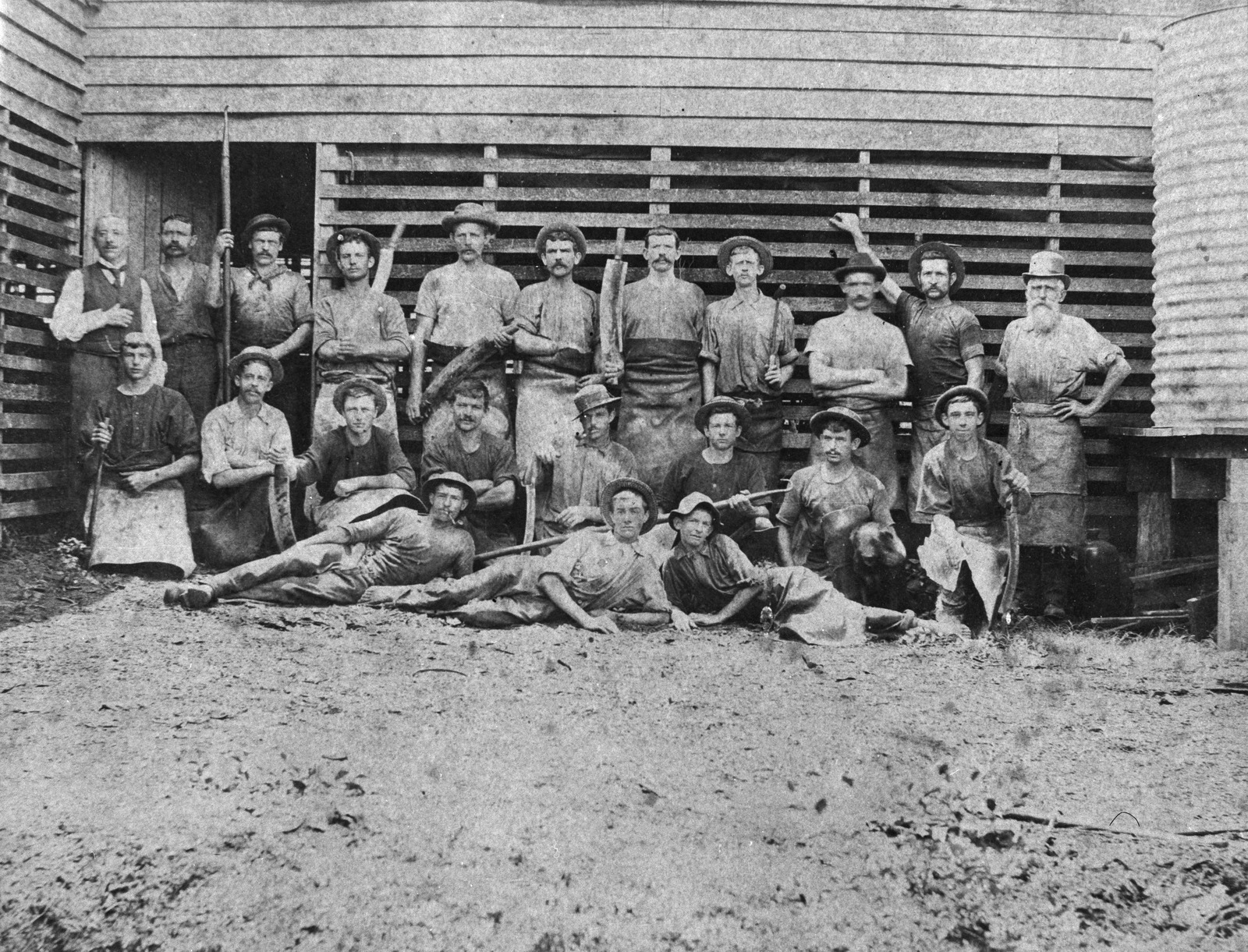The Pioneering Hide, Skin and Leather Industries of Brisbane: Tanneries of Greater Brisbane [Part 1]
By Dr Robin Trotter - 2024 Queensland Business Leaders Hall of Fame Fellow | 25 July 2024
Guest blogger: Dr Robin Trotter - 2024 Queensland Business Leaders Hall of Fame Fellow
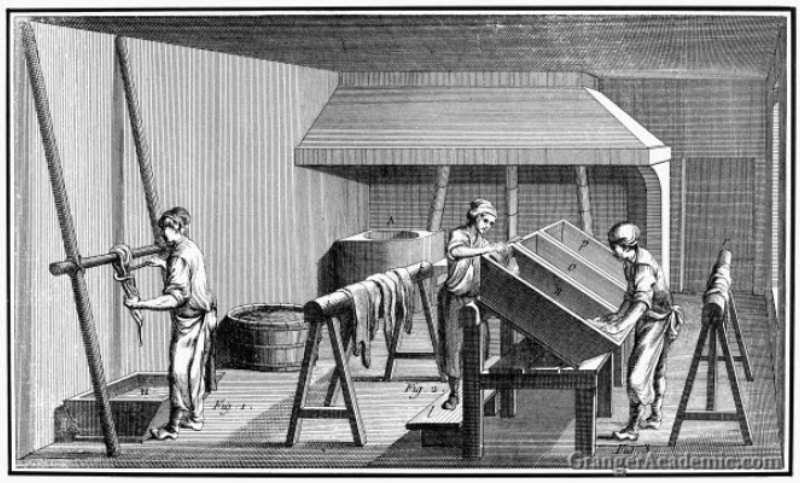
Tanning - An Ancient Craft: An 18th century French copper engraving showing the distinctive feature of dyeing goatskins before tanning into moroccoed leather. Image courtesy of Grangeracademic.
In evaluating rural based economies –particularly in the case of Queensland - the focus on wool production tends to obscure the value of the cattle industry in this pioneer economy. As Ginn (Queensland Historical Atlas) points out, it was both sheep and cattle that were the ‘cornerstone of the colonial economy’:
After two decades of land seizure and frontier bloodshed, by 1859 the pastoral grazing of sheep and cattle had completely transformed at least a quarter of the land use in Queensland and had become the cornerstone of the colonial economy.[1]
Tallow and hides were by-products of raising sheep and cattle for wool and meat. And these products would form the basis of the pioneer industrial economy of the new colony. So, by the latter part of the C19 there was a proliferation of new industries: boiling down works (especially during times of drought or downturn in markets), wool scours, fellmongers and tanneries – all producing and manufacturing products either for export or to replace imports for the local domestic market: tallow, candles shoes, saddlery and a range of other leather products. Mapping Brisbane tells us there were several ‘boiling down’ works operating in the area of Kangaroo Point as early as the 1840s, with two early operations being those owned by Evan Mackenzie and John Campbell.[2]

Early sketch of Kangaroo Point Brisbane, 1860s, John Oxley Library, State Library of Queensland. Negative number: 88349

Portrait of Sir Evan Mackenzie, Anon, 2005, John Oxley Library, State Library of Queensland. Negative number: 66746
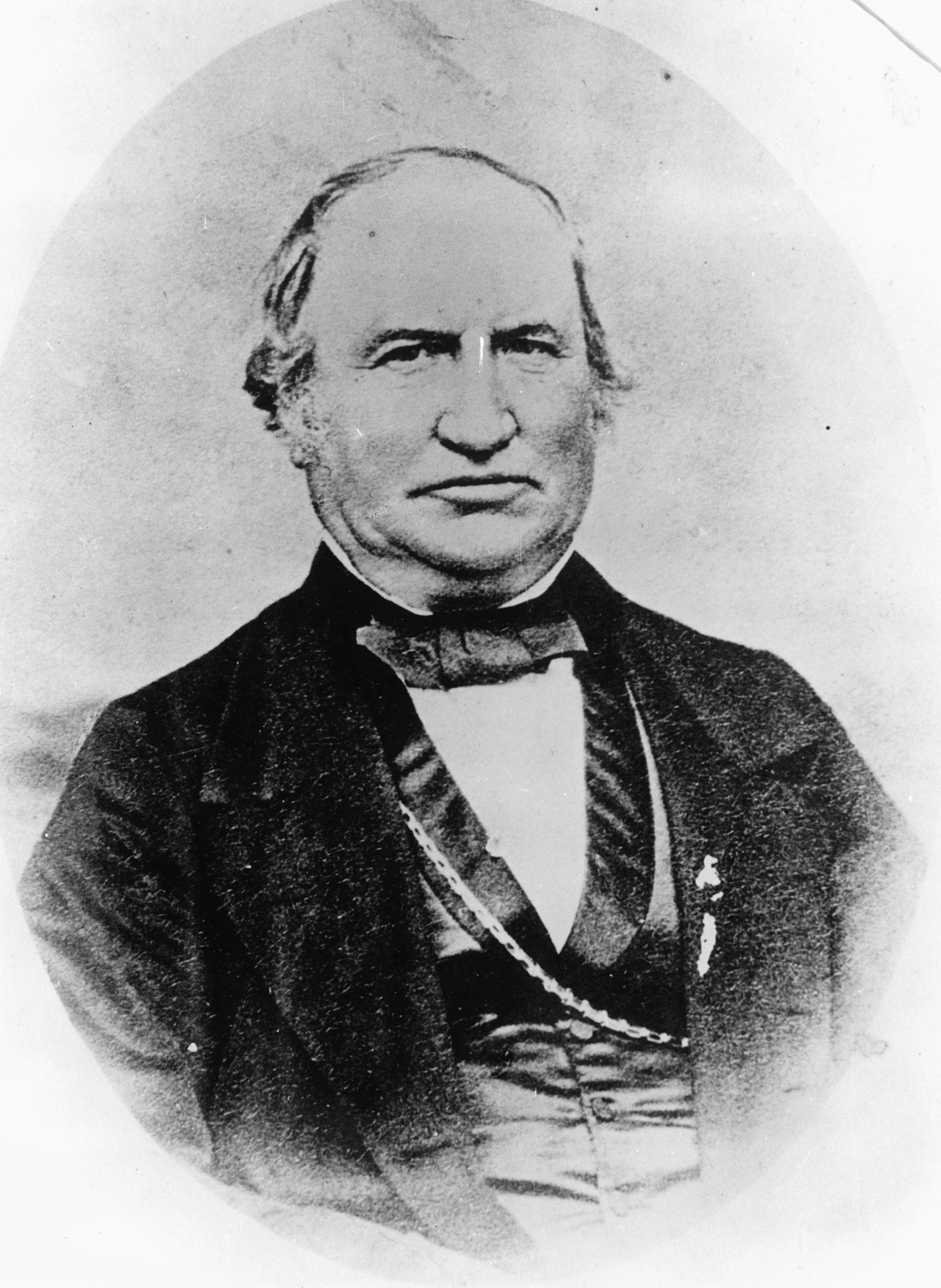
Portrait of John’Tinker’ Campbell, Anon, 2004, John Oxley Library, State Library of Queensland. Negative number: 84346
Wool Scours
Scours: Scouring or washing is the first mechanical process that wool goes through, to remove grease and dirt from fleece. Carbonising is unique to the woollen system and breaks down any remaining impurities after scouring.
Carbonising is the chemical process employed for the removal of burrs, shive [grass] and other vegetable matter from scoured wool. The technique consists of treating the wool with dilute sulphuric acid and baking the acid-treated wool to char the VM so that it can be removed by mechanical means.
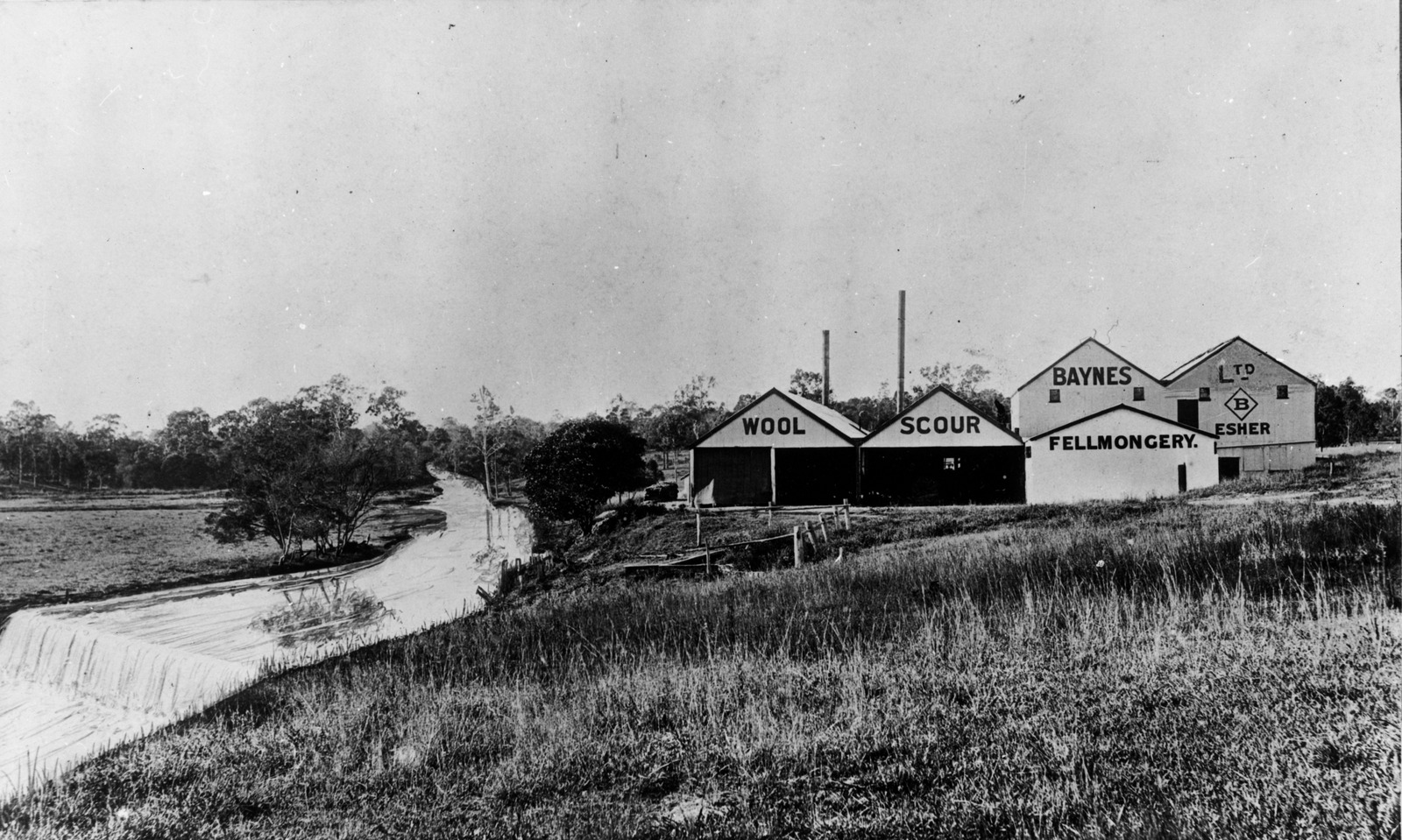
Baynes' Fellmongery and Wool Scour at Belmont, Brisbane, ca. 1910, Anon, 2004, John Oxley Library, State Library of Queensland. Negative number: 22206
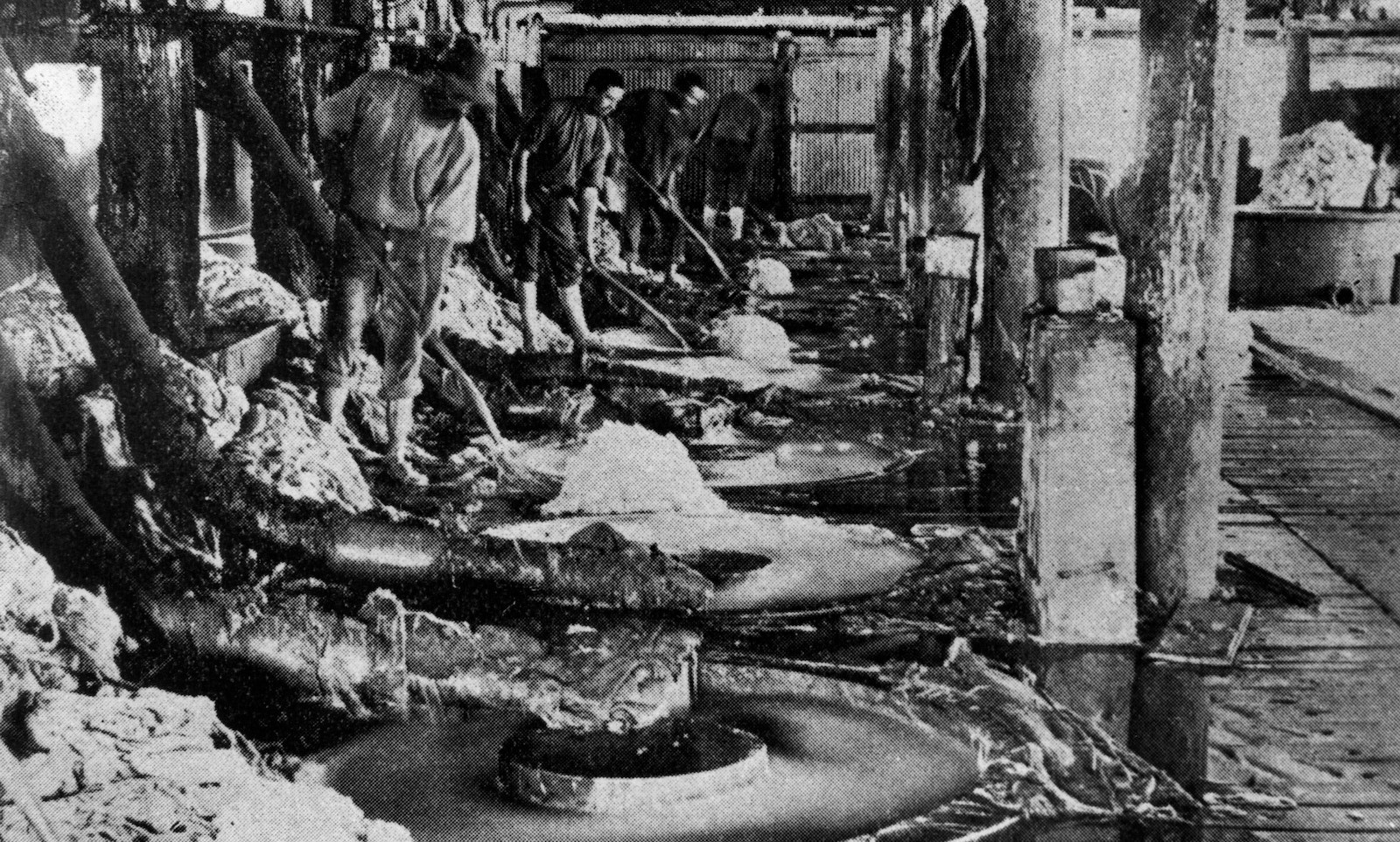
Wool scouring at Belmont, Brisbane in 1900, Anon, 2004, Oxley Library, State Library of Queensland. Negative number: 16336
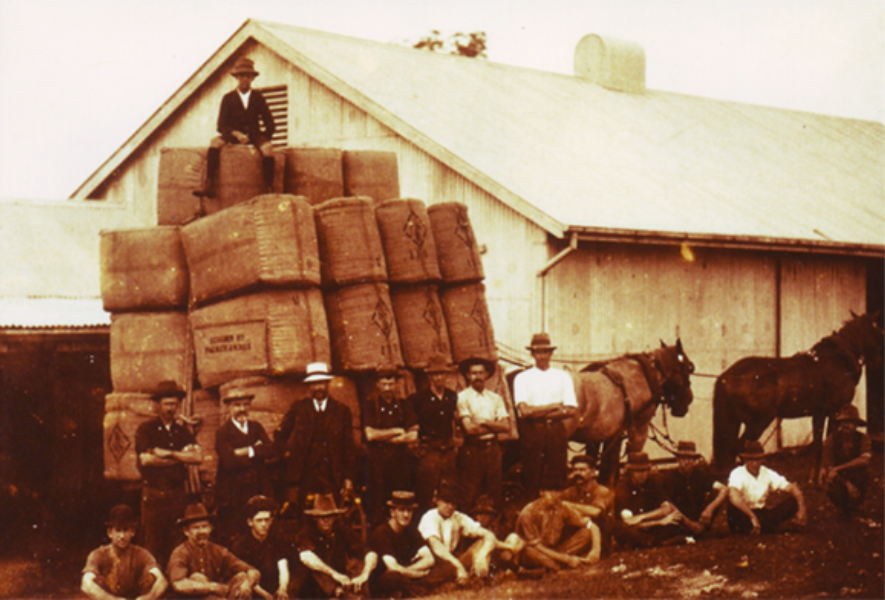
Drayload of wool at Packer’s Wool scour, Chermside. Image courtesy of 96.5FM.
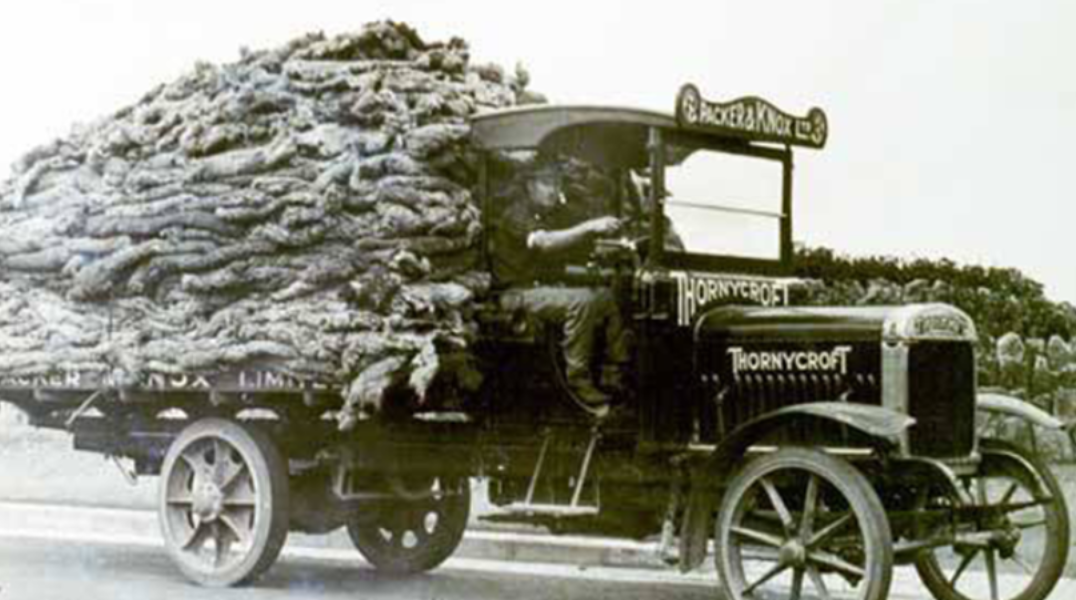
Truckload of hides at Packer’s Wool scour, Chermside. Image courtesy of 96.5FM.
Fellmongers
Fellmongery: A different process to wool scouring, fellmongering processed sheepskins in order to remove the wool in preparation for tanning. The wool was washed and dried, and the skins were processed into leather.
Wool scouring and fellmongering were sometimes located within the same operation, or tended to be clustered in close proximity, along with tanneries. Slaughter yards were also sometimes run in conjunction with fellmongeries. They tended to be located alongside a creek to enable a good supply of clean, fresh water - a key element in the processing of the skins and wool.
Thomas Blackett Stephens was an early pioneer and land owner in first the Ormiston area and then the Ekibin district. He established his first fellmongery/wool scour on the banks of Hilliards Creek, Ormiston, in 1853 and in the early 1860s moved the operation to Ekibin where the business thrived. [3] Later a farming business was added and became one of the largest operations in the area. After Stephens vacated the Ormiston site, Thomas Alford re-established another fellmongery on the same site. This operated from 1894 to 1920. [4] The image below shows a view of Stephen’s works at Ekibin.
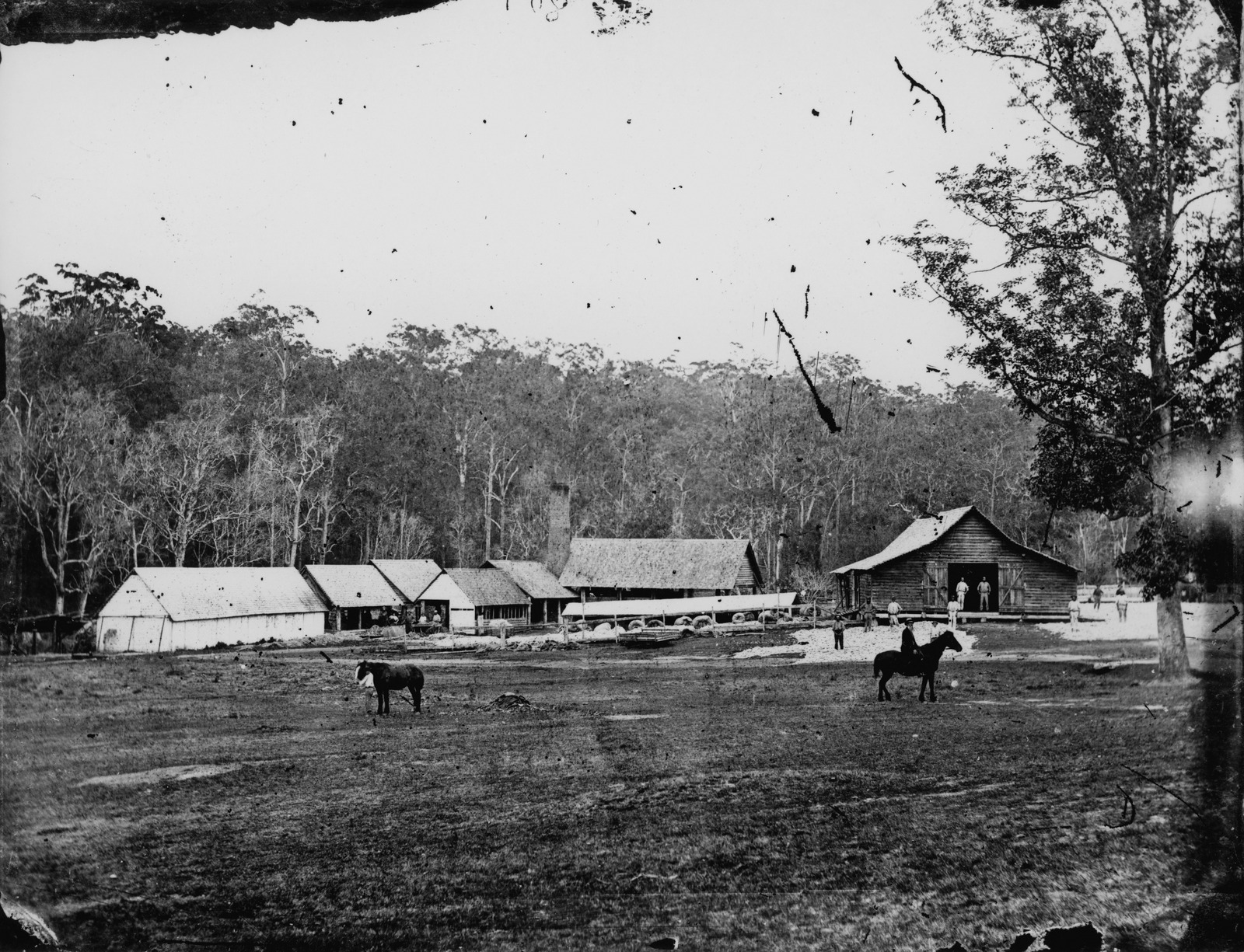
T.B. Stephens' fellmongery at Ekibin, Brisbane, Queensland, ca. 1871, William Boag, 1838-1878, John Oxley Library, State Library of Queensland. Negative number: 20162
Tanneries
Tanning: Hide tanning is the process of treating skins and hides of animals to produce leather. Tanning hide into leather involves a process which permanently alters the protein structure of skin, making it more durable and less susceptible to decomposition and colouring. Before tanning, the skins are often dehaired, then have fat, meat and connective tissue removed. They are then washed and soaked in water with various compounds, and prepared to receive a tanning agent. They are then soaked, stretched, dried, and sometimes smoked. Historically this process was considered a noxious or "odoriferous trade" and relegated to the outskirts of town.
Historically, vegetable based tanning used tannin, an acidic chemical compound derived from the bark of certain trees, in the production of leather. An alternative method, developed in the 1800s, is chrome tanning, where chromium salts are used instead of natural tannins (Wikipedia).
Below are images of some of the tanneries to be found in and around Brisbane in the late nineteenth and early twentieth centuries. Whilst widely dispersed around Brisbane, there were several areas where there was a concentration of tanning operations. The Kedron area, with a reliable source of water, Kedron Brook, (an essential component of the tanning process – for the treatment of skins), became a ‘hub’ for tanners. Kedron Brook has a large catchment area (over 110 sq. kilometres) and incorporates the suburbs of Ferny Grove, Mitchelton, Everton Park, Keperra, Enoggera, Stafford, Lutwyche, Kedron, Wooloowin, Clayfield, Nundah, Northgate, Toombul and Nudgee.[5]
The Newmarket/Enoggera area was another such ‘hub’ Here, the Enoggera/Breakfast Creeks catchment includes the suburbs of the Gap, Ashgrove, Bardon, Red Hill, Enoggera, Paddington, Newmarket, Wilston, Windsor, Kelvin Grove, Herston, Spring Hill, Fortitude Valley, Albion, Lutwyche, Clayfield, Bowen Hills and Newstead.[6]
Kedron Area Tanneries
A report in the Brisbane Courier in 1900 noted that there were ‘some fifteen tanneries’ in the Kedron area. The occasion being reported on was a deputation to the Minister for Railways requesting a railway siding be installed at Woollowin to meet the transport needs of local businesses, Tannery operators were to the fore of the deputation.[7]
The proximity of Kedron Brook encouraged ‘skin trade’ pioneers, Michael Joseph Gallagher and Paul Maggs, to set up tanneries. Gallagher’s Kedron Tannery, was established in 1886 and was located on the western side of Gympie road and upstream from the other tanneries on the creek. It closed in 1960.[8]
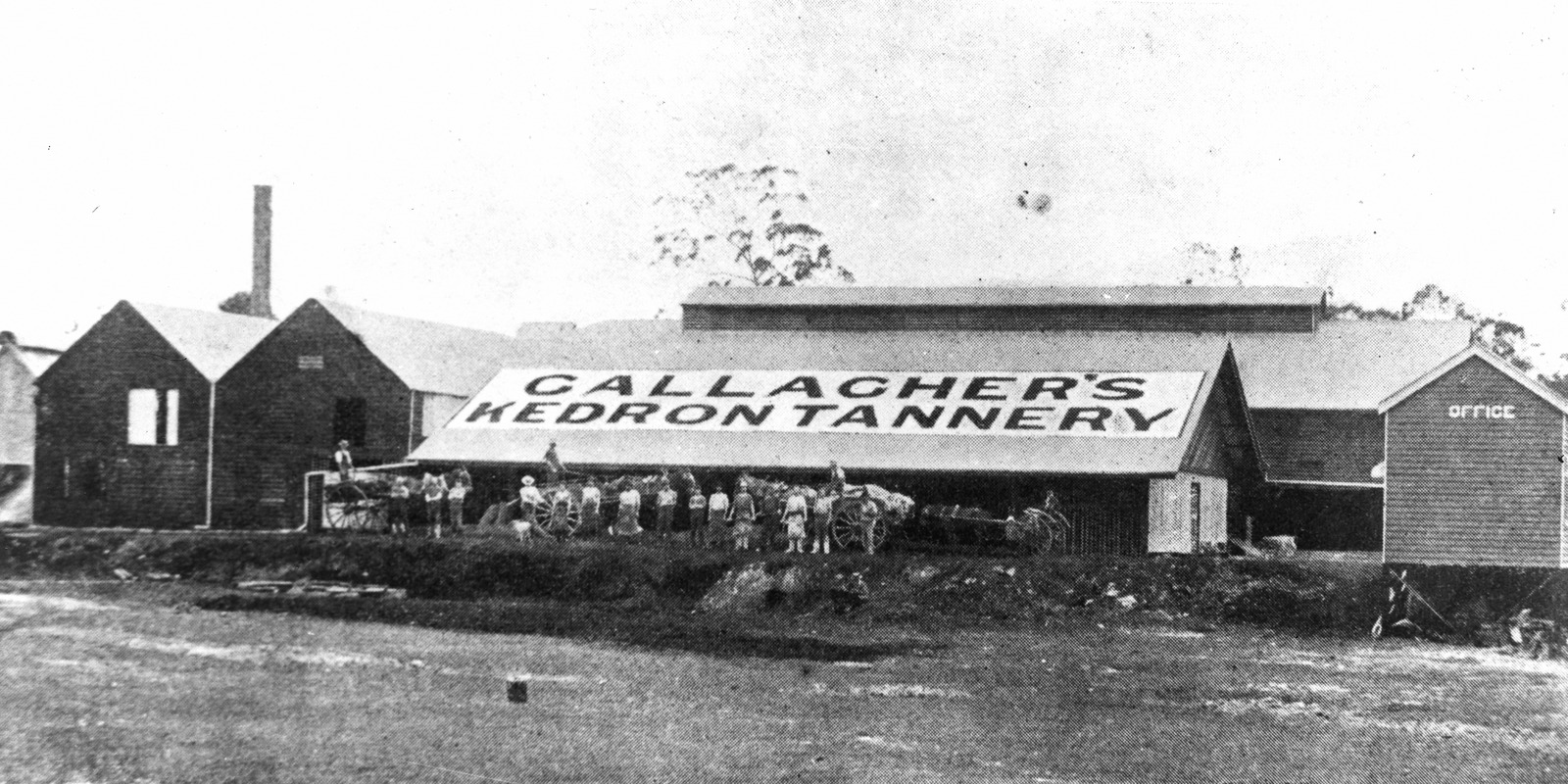
Gallagher's Kedron Tannery, Brisbane, 1902, John Oxley Library, State Library of Queensland. Negative number: 6530
Maggs set up his tannery three years after Gallagher’s initial operation, with the first of his tanneries, the Avondale Tannery (established 1889 and sold 1894) in Stafford Road, Stafford, and the Edinburgh Tannery (1889-1904) located in Nundah Street, Kedron, alongside Kedron Creek. Several years later –in 1906 – Maggs opened another tannery downstream – the Bristol Tannery (1906–c.1966). When Maggs disposed of the Edinburgh Tannery in 1904, it was purchased by Arthur Edward Cornell who had, in 1882, set up the Brisbane Tannery on Kedron Brook, Lutwyche Road, Lutwyche, but he had had to let it go in 1890 or 1891.[9] So, this was his re-entry back into the tanning business. Here, and elsewhere, there is evidence some tanneries could be short lived, or could change hands at various times, and could also diversify or morph into different ventures, e.g., fellmongering or leather trading.
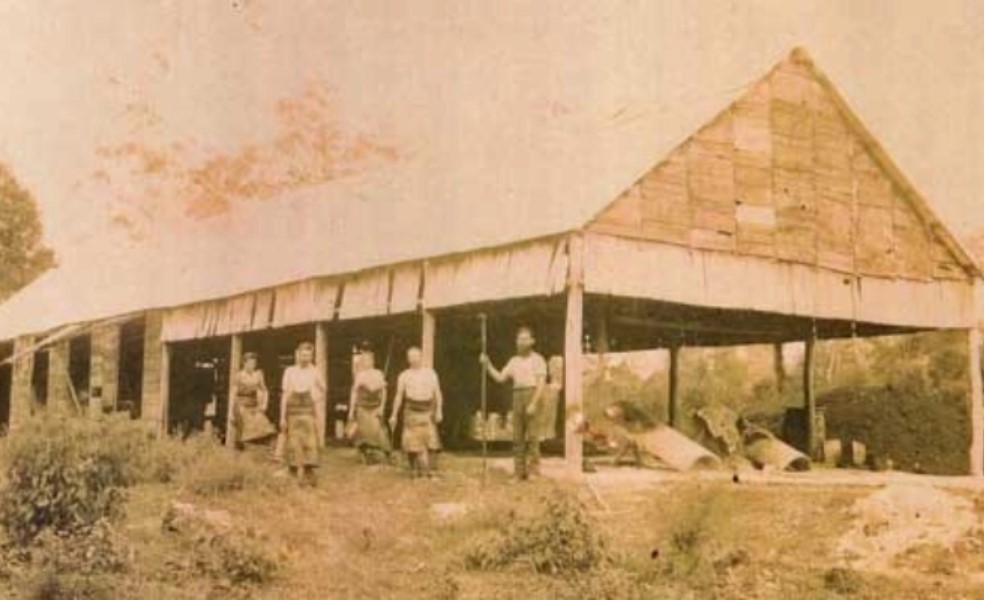
Maggs’ Edinburgh Tannery, Kedron. Courtesy of Chermside & Districts Historical Society/ Facebook
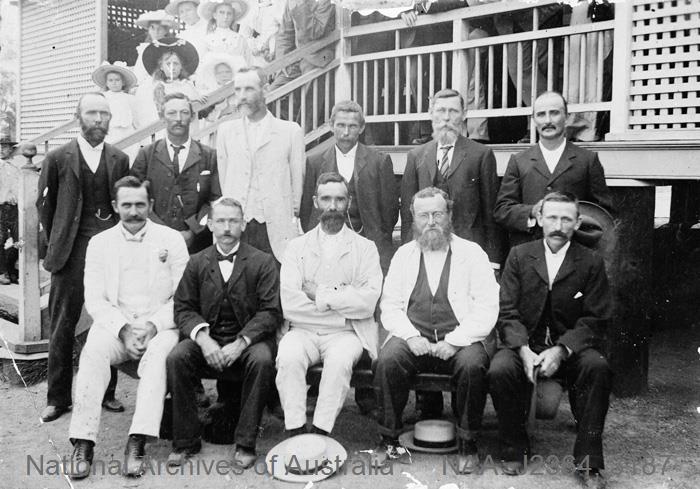
Paul Maggs, seated left-most side, ca 1900. Image courtesy of National Archives of Australia. Item ID 507846.
Another tannery in the area was on Stafford Road, Kedron. Know as Scotia Works or Scotia Tannery, it was started up by brothers Joseph and William Gibson in 1887. They traded under the name of Wm Gibson & Sons Ltd. Both brothers died in 1939 but the tannery continued up until 1982.[10]
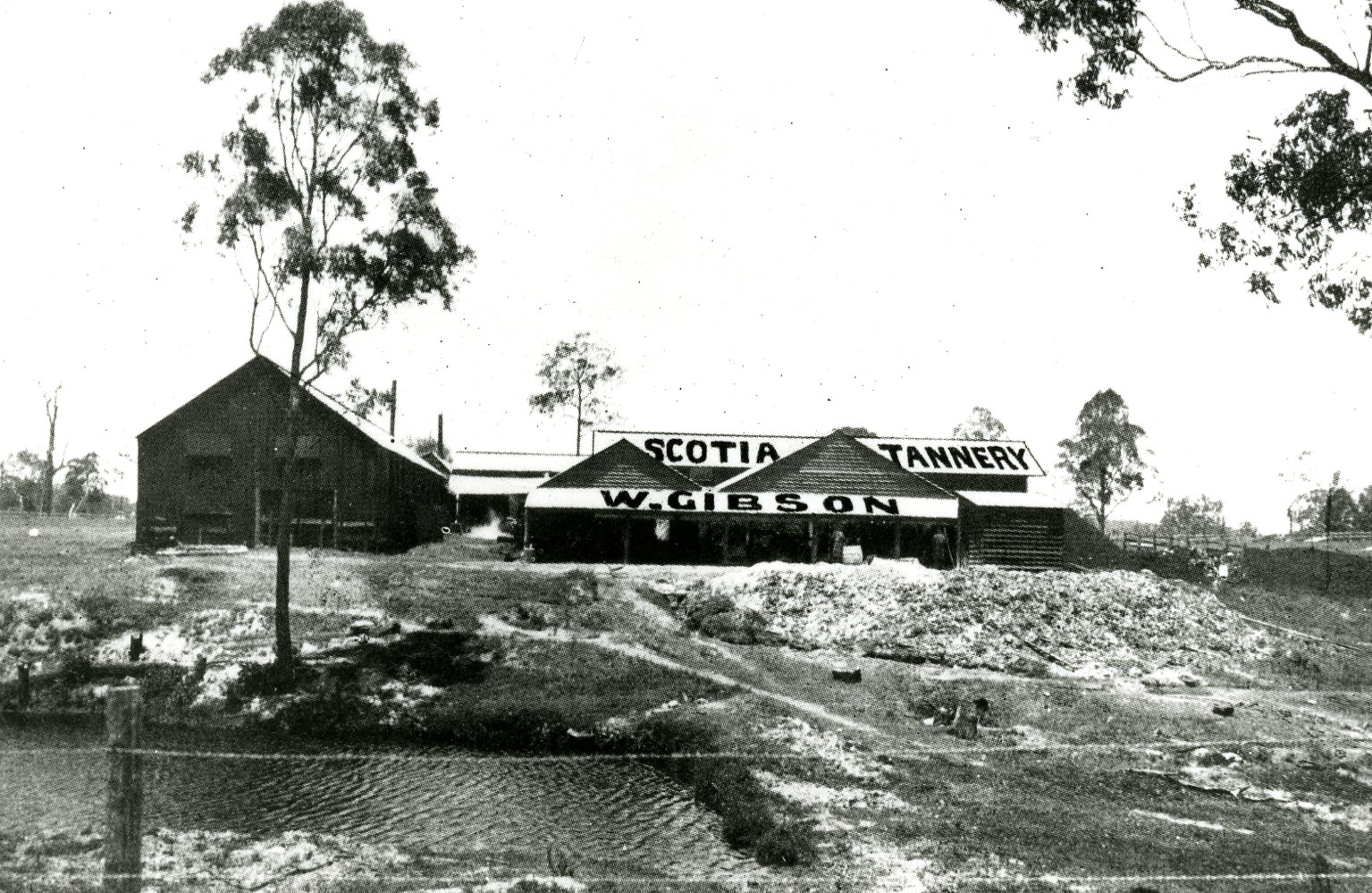
Stafford Tannery, established by William Gibson and known as the Soctia Tannery. Image courtesy of Brisbane City Council Libraries. Identifier: BCC-B120-31401.
Newmarket Area Tanneries
Access to water was not the only drawcard for a tannery. In the Newmarket/Enoggera area there was, from 1877, another ‘attraction’ - the Enoggera Cattle Saleyards. Brisbane’s earliest official saleyards had been constructed in 1864 between Roma and Albert Streets, but a decade later the yards were, according to the Brisbane Courier: ‘One of the most discreditable pieces of property to which the Corporation of Brisbane lays claim’.[11] The decision was to transfer the Saleyards to what was then the Shire of Windsor, to an area just north of Enoggera Creek. With both water and the saleyards, the districts around Enoggera, Newmarket, Alderley and south to Red Hill and Kelvin Grove, saw a number of new tanneries opening up.[12]
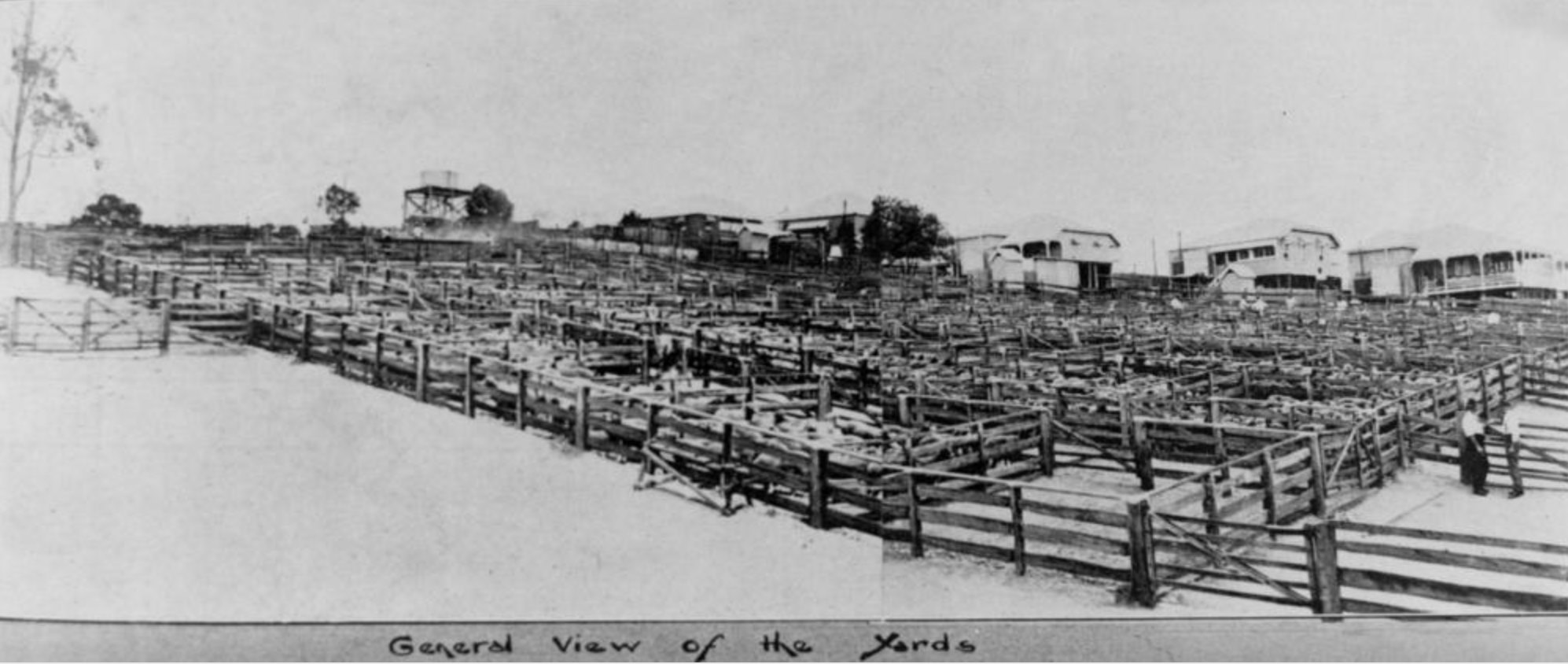
Enoggera Cattle Sale Yards, Newmarket. Image courtesy of Cairns Family History Website
According to the Telegraph’s obituary notice, Sven Erick Granlund was ‘one of the oldest master tanners of Brisbane’. Of Swedish origin, aged 47, Granlund came to Queensland in 1879 and for a period worked in the T C Dixon & Sons Tannery at Hill End until he left to establish his own operation in Bishop Street, Kelvin Grove: Wetzig and Granlunds and Co., Tanners and Saddlers.[13] By 1899 we find he also had a tannery in Free Street, Newmarket.
We also have another tannery in this general area – the Bermondsey Tannery – built by Robert Fulcher, in Tannery Lane, (now Fulcher Street), Red Hill. Today, this address is the home of the Brisbane Broncos.
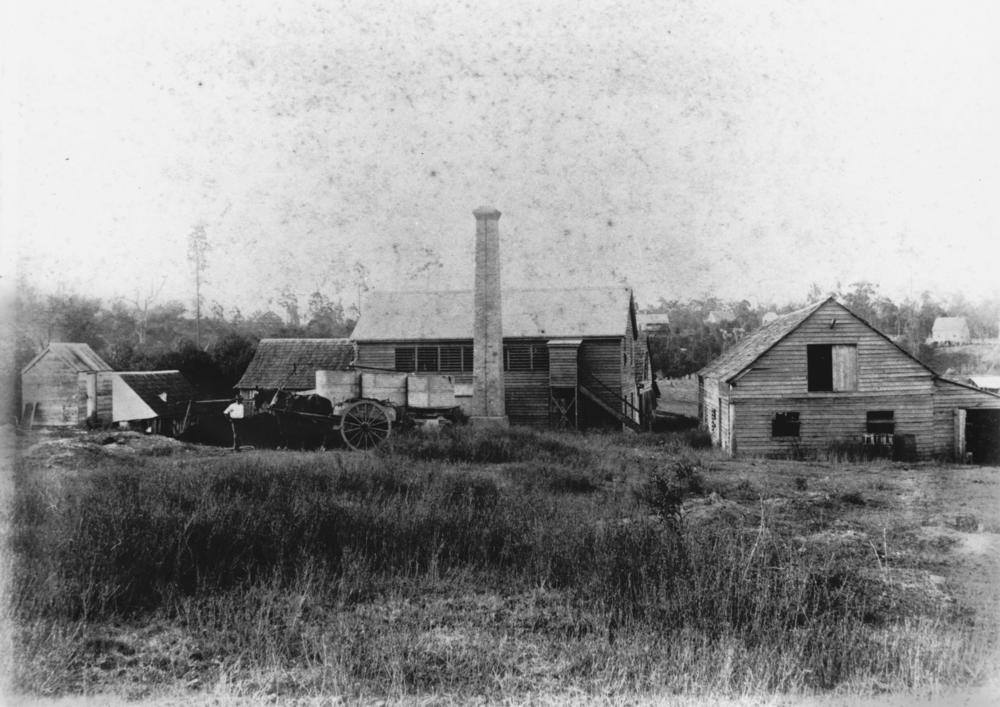
Robert Fulcher's Bermondsey Tannery, Tannery St (now Fulcher St), Red Hill, ca. 1902, John Oxley Library, State Library of Queensland. Negative number: 152471
Although established somewhat earlier than the opening of the Enoggera Saleyards in 1877, Charles Mackler opened up a tannery in Newmarket in 1868.
Initially he had been in partnership with George Rose but in 1877 the partnership was dissolved and Mackler continued to trade under the name of C Mackler & Co. Tanners and Leather Merchants. [14]
Mackler also had this shop [right] at 134 Ann Street, Brisbane by the early 1900s (information with image suggests the figure in the doorway would likely be Charles Mackler). [15]
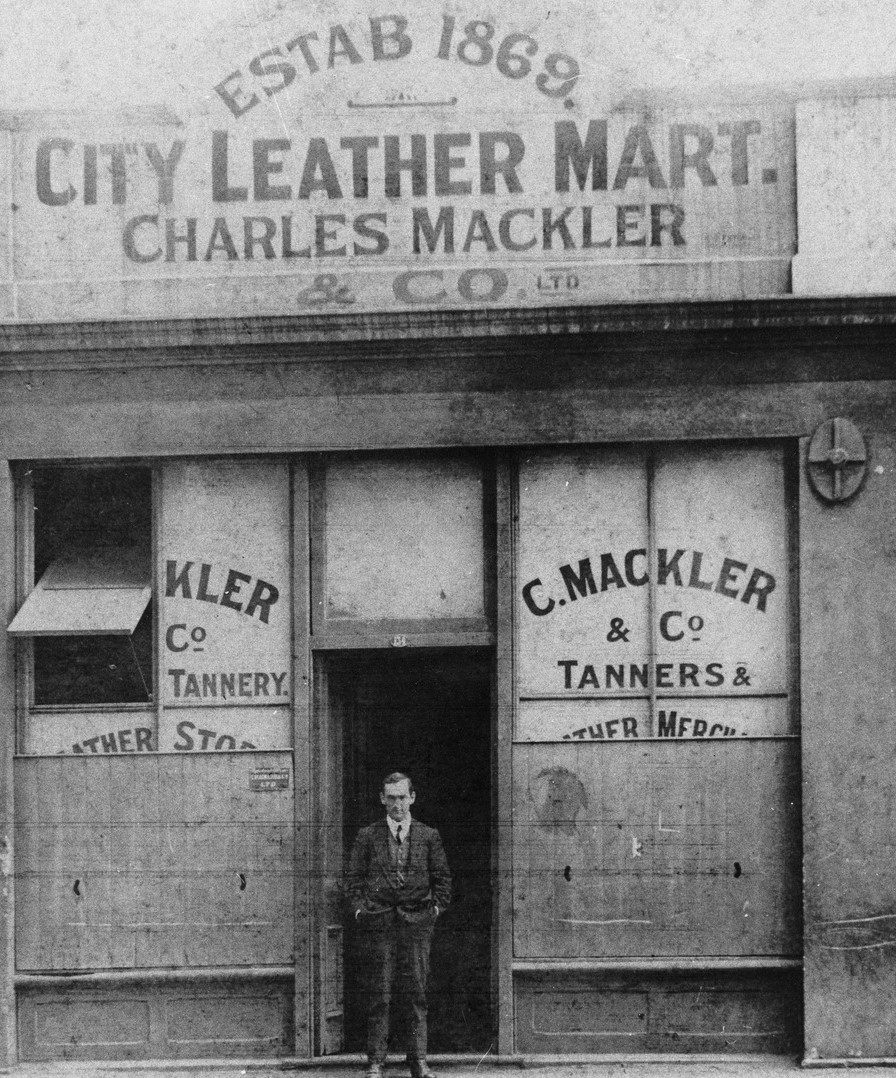
Business premises of Charles Mackler & Co., Elizabeth Street, ca. 1918, John Oxley Library, State Library of Queensland. Negative number: 167213
Tanneries - Other Areas of Brisbane
Expanding this overview of Brisbane tanneries, one of the earliest was that of W Ewart.
The Queenslander, 25 August, 1866, carried a comprehensive report on his, apparently recently established, tanning operation. Various accounts of this Brisbane Tannery [as opposed to the Brisbane Tannery on the north side] locate it at Toowong, Indooroopilly, or ‘near Moggill Road’. Ewart also had a retail outlet for his leather (right):
In 1871 Ewart was offering the property for sale and after that date there appears to be an historical silence on Mr Ewart and his tannery.
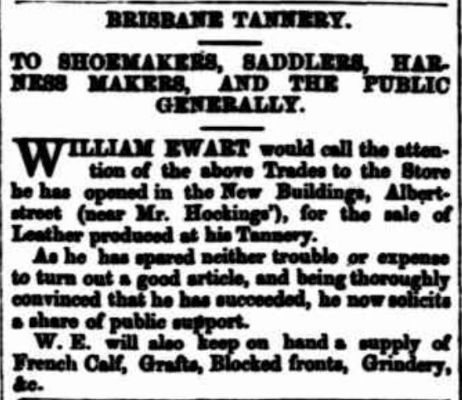
The Queenslander, 21 July 1866 (pg1). Image courtesy of Trove, National Library of Australia. Page identifier: 2458546
On the south side of the Brisbane River, T B Stephen’s wool scour and –- as already mentioned – was expanded into a tannery as well. Stephens also constructed a number of shingle roofed cottages for some of his employees. [16]
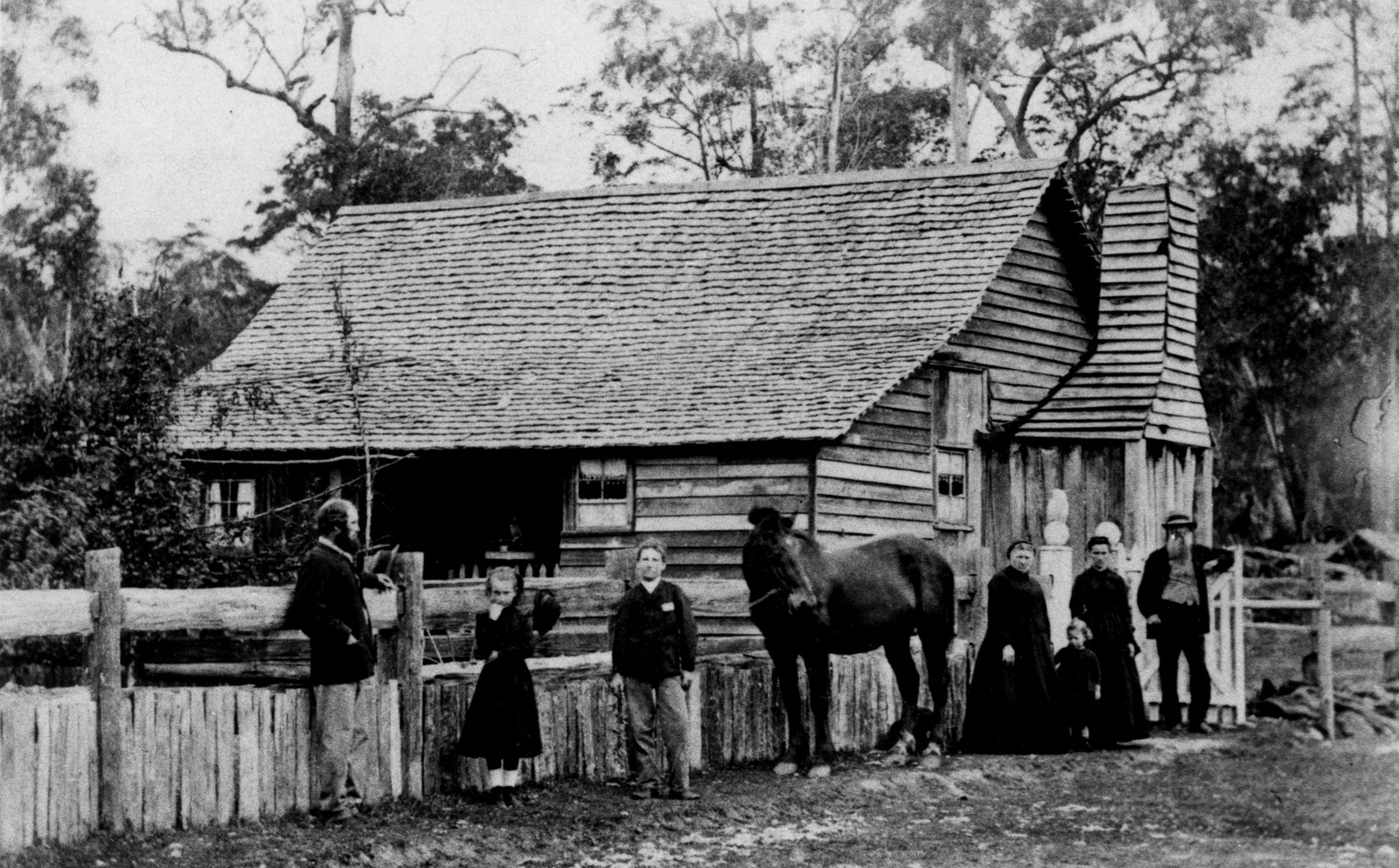
Cottage of an employee of T.B. Stephens at his Ekibin tannery, Brisbane, Queensland, ca. 1871, John Oxley Library, State Library of Queensland. Negative number: 9343
In the eastern area of Brisbane was the Keralgere Tannery at Morningside. There is a complicated history to this tannery, as the Brisbane City Council Heritage Register records.
One of the earliest residents in Morningside was Edmund Rossiter who arrived in 1875, and after owning and operating the Enoggera Hotel, Kelvin Grove in the 1860s and 1870s, Rossiter must have moved into tanning as in March, 1880, the Brisbane Courier reported that E Rossiter of Bulimba had won third prize at the International Exhibition for rugs and mats made from marsupial skins. Rossiter was first mentioned in the Post Office Directories as carrying on a tannery in Cleveland Road in 1885–86. In 1874 Edmund’s daughter, Elizabeth married Thomas Boasley and Thomas and his brother operated a tannery at Kelvin Grove c.1885. From 1891 Rossiter’s tannery appeared as the Keralgere Tannery, which was said to have been an Aboriginal word for the chain of waterholes on which it was built and from around 1892 Rossiter Brothers were reported as operating the Keralgere Tannery. Initially intended for marsupial skins, the business grew large enough to accept any hides. The tannery was very important in Morningside as one of the first established industries in the area.[17]
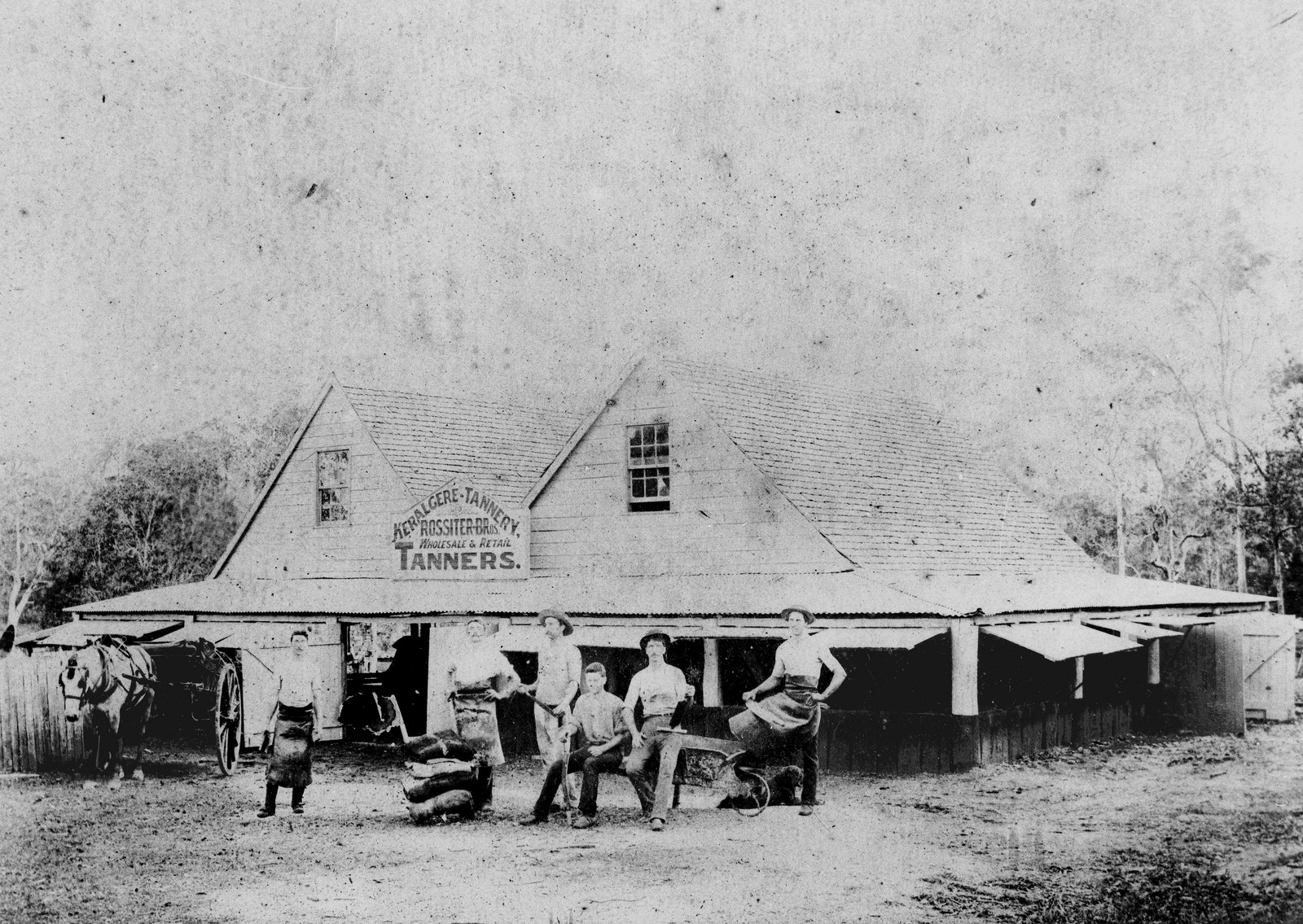
Workers pose outside the Keralgere Tannery at Morningside, Brisbane, ca. 1897, John Oxley Library, State Library of Queensland. Negative number: 156917
Again, on the north side of Brisbane, in the Nundah/Cabbage Tree Creeks catchment, Joseph Packer and David Knox started up a tannery in Chermside in 1891. Initially starting out with a wool scour and fellmongery (see wool scours above), the operation later also moved into tanning and continued until closure in 1971. Joseph had bought out the Knox family holdings early and since that time Packer Leather has been a one family business. Lindsay Packer, descendent of Joseph, started up a new tannery a year after closure of the Chermside tannery – but in a new location – Narangba. Packer Leather continues today as one of only a few remaining tanneries in Australia. [18]
Wool drying in front of Packer Leather’s wool scour and tannery at Chermside, Image courtesy of 96.5FM.
These are only a few of the Tanneries that were built, exchanged, taken over, dissolved, or continued into the next century – and even fewer, into the twenty-first century.
Part 2 takes a closer look at two tanneries that not only continued into the twenty-first century but thrived – at least up until the impact of globalisation and a raft of other factors. These were: the T C Dixon & Sons Tannery in West End, and Donald Dixon’s Tannery in Hemmant.
Read part 2 of this blog - The Pioneering Hide, Skin and Leather Industries of Brisbane: The Dixon Tanneries [Part 2]
Dr Robin Trotter
Do you know a Queensland business history story that needs celebrating and recording? If so the Queensland Business Leaders Hall of Fame Fellowship is for you! Applications for the 2025 Queensland Buisness Leaders Hall of Fame Fellowship close at midnight 14 August 2024.
References
[1] Ginn, G, 2024, ‘Pastoralism: 1860s-1915’, https://www.qhatlas.com.au/pastoralism-1860s-1915.
[2] Mackenzie’s Boiling Down Works, https://mappingbrisbanehistory.com.au/history-location/mackenzies-boiling-down-works-248/; H. J. Gibbney, 'Mackenzie, Sir Evan (1816–1883)', Australian Dictionary of Biography, National Centre of Biography, Australian National University, https://adb.anu.edu.au/biography/mackenzie-sir-evan-4108/text6567, published first in hardcopy 1974, accessed online 10 June 2024H.R.; Judith Iltis, 'Campbell, John (Tinker) (?–1878)', Australian Dictionary of Biography, National Centre of Biography, Australian National University, https://adb.anu.edu.au/biography/campbell-john-tinker-1874/text2193, published first in hardcopy 1966, accessed online 10 June 2024).
[3] ..O’Brien & Dean, 1976; Ormiston Fellmongery, Heritage Register, https://apps.des.qld.gov.au/heritage-register/detail/?id=645606).
[4] ‘Ormiston Fellmongery’, 1894, Brisbane Courier, 7 August, p.4’
[5] Know Your Creek: Kedron Brook, Brisbane City Council, Brisbane.
[6] Know Your Creek: Enoggera/Breakfast Creeks, Brisbane City Council, Brisbane.
[7] ‘Wooloowin Railway Siding Deputation to the Minister for Railways’, 1900, Brisbane Courier, Monday, 11 June, p.3.
[8] ‘Kedron: A 19th Century Hub for the ‘Skin Trade’, 2023, Kedron Today, https://kedrontoday.com.au/kedron-tanneries-hub-skin-trade-19th-century/
[9] ‘Cornwall Tannery and Home of Phil Stephen, Tannery owner’, Mapping Brisbane History, https://mappingbrisbanehistory.com.au/history-location/cornwall-tannery-and-home-of-phil-stephen-tannery-owner-559/
[10] ‘Scotia Works’, Chermside and District Historical Society, https://www.facebook.com/photo.php?fbid=732172328949305&id=100064696329024&set=a.462334239266450; ‘Death Of Founder Of Gibson's Kedron Tannery’, 1939, Sunday Mail, 17 December, p.12.
[11] ‘Telegraphic’, 1870, Brisbane Courier, 25 February, p.2.
[12] Newmarket, Queensland Place Names, https://queenslandplaces.com.au/newmarket?fbclid=IwAR0kNFX2IlSRYaWohs79aQpYnhFMonD2hcYwafrbl92Bz9b7aZMCUMjF8w8).
[13] Granlund, S., 1925, Obituary, Telegraph, Saturday 27 June, p.13.
[14] ‘Public Notice’, Brisbane Courier, 11 December, 1877, p.1
[15] ‘A Newmarket House’, The House Detective, https://www.housedetective.com.au/newmarket
[16] Wool scour and Fellmongery, Mapping Brisbane History, https://mappingbrisbanehistory.com.au/history-location/woolscour-and-fellmongery-80/
[17] Brisbane City Council Heritage Citation: A G H Rossiter House, https://heritage.brisbane.qld.gov.au/sites/default/files/citation/a-g-h-rossiter-house_2168.pdf?t=1716627148
[18] ‘World Class Leather Business Celebrates 130 Years’, https://www.96five.com/stories/life/news/2021/world-class-performance-leather-business-celebrates-130-years
Other blogs by Dr Robin Trotter, 2021 and 2024 Queensland Business Leaders Hall of Fame Fellow
- Bootmakers of Brisbane [Part 1]
- Bootmakers of Brisbane [Part 2]
- The Pioneering Hide, Skin and Leather Industries of Brisbane: The Dixon Tanneries [Part 2]
- Frank McDonnell And The Early Closing Movement
- How to make a Carton: history of paper making in Australia
- The making of a Knight: Sir Arthur Petfield
- A Career in Cards
- How Napoleon's pistols came to Queensland
- Sir Arthur Petfield and 'The World Shrinkers'
Dr Robin Trotter's Research Reveals talk.
Comments
Your email address will not be published.
We welcome relevant, respectful comments.

